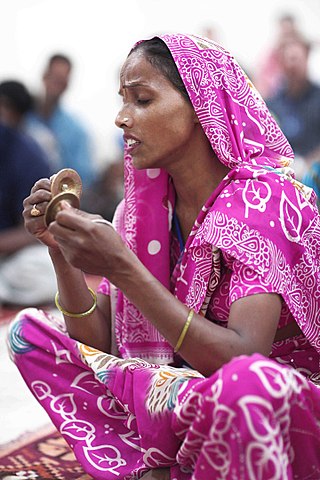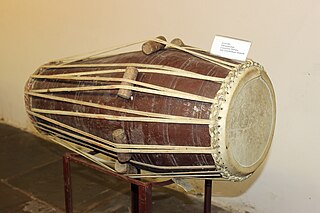In music, an ostinato is a motif or phrase that persistently repeats in the same musical voice, frequently in the same pitch. Well-known ostinato-based pieces include classical compositions such as Ravel's Boléro and the Carol of the Bells, and popular songs such as John Lennon’s “Mind Games”(1973), Donna Summer and Giorgio Moroder's "I Feel Love" (1977), Henry Mancini's theme from Peter Gunn (1959), The Who's "Baba O'Riley" (1971), The Verve's "Bitter Sweet Symphony" (1997), and Flo Rida's "Low" (2007).
Dhrupad is a genre in Hindustani classical music from the Indian subcontinent. It is the oldest known style of major vocal styles associated with Hindustani classical music, and is also related to the South Indian Carnatic tradition. It is a term of Sanskrit origin, derived from dhruva and pada. The roots of Dhrupad are ancient. It is discussed in the Hindu Sanskrit text Natyashastra, and other ancient and medieval Sanskrit texts, such as chapter 33 of Book 10 in the Bhagavata Purana, where the theories of music and devotional songs for Krishna are summarized.
Khyal or Khayal is a major form of Hindustani classical music in the Indian subcontinent. Its name comes from a Persian/Arabic word meaning "imagination". Khyal is associated with romantic poetry, and allows the performer greater freedom of expression than dhrupad and is sung with the tabla instead of the pakhavaj. In khyal, ragas are extensively ornamented, and the style calls for more technical virtuosity.

Indian classical music is the classical music of the Indian subcontinent. It is generally described using terms like Shastriya Sangeet and Marg Sangeet. It has two major traditions: the North Indian classical music known as Hindustani and the South Indian expression known as Carnatic. These traditions were not distinct until about the 15th century. During the period of Mughal rule of the Indian subcontinent, the traditions separated and evolved into distinct forms. Hindustani music emphasizes improvisation and exploration of all aspects of a raga, while Carnatic performances tend to be short composition-based. However, the two systems continue to have more common features than differences. Another unique classical music tradition from the eastern part of India is Odissi music, which has evolved over the last two thousand years.
Ektal or Ektaal is a tala in Indian music. It is commonly used in classical music like kheyal, and semi-classical forms like Rabindra Sangeet. In ektal the 12 matras are divided into 6 vibhags of two matras each. Ektal is played in Drut gatti. This tala is mostly played by the use of tabla. One more tala similar to Ektal is Chowtal which is played with the use of Pakhavaj, Ektaal is the tabla counterpart of Chowtaal. Many beautiful Kaida are played in Ektal. But Ektal is mostly played for Vilambit.
'Vibhag' represents a duration of rhythmic phrasing in Indian classical music made up of a certain number of beats. They are the rough equivalent of bars in western music, but instead of always being equal subdivisions of the tala, they can be uneven. In certain traditions of [ [music of India|Indian music]], any number of [beat (music)|beats] may form a 'Vibhag'. Usually the beats will be in two, three, or four. They should be designated either with a clap or a wave of the hand. The meaning of the word Bhag from is parts. The actual measure of the Vibhag is borders or boundaries or boundary lines, in short not in continuity or not continuous. The talas in Tabla or in any other percussion instrument in classical music have Vibhagas to get a track of the beats on Matras on which the singer or player is singing or playing on. For example taking different talas,
Teentaal is the most common taal of Hindustani music, and is used for drut. It is symmetrical and presents a very simple rhythmic structure against which a performance can be laid. It is of 16 beats with 4/4/4/4/ pattern and 4 divisions.There are 3 claps(tali) and 1 gap(khali).

A tala literally means a 'clap, tapping one's hand on one's arm, a musical measure'. It is the term used in Indian classical music similar to musical meter, that is any rhythmic beat or strike that measures musical time. The measure is typically established by hand clapping, waving, touching fingers on thigh or the other hand, verbally, striking of small cymbals, or a percussion instrument in the Indian subcontinental traditions. Along with raga which forms the fabric of a melodic structure, the tala forms the life cycle and thereby constitutes one of the two foundational elements of Indian music.

Ustad Amir Khan was an Indian singer and musician in the Hindustani classical tradition. He was the founder of the Indore gharana.
Vaeakau-Taumako is a Polynesian language spoken in some of the Reef Islands as well as in the Taumako Islands in the Temotu province of Solomon Islands.
Dutch orthography uses the Latin alphabet. The spelling system is issued by government decree and is compulsory for all government documentation and educational establishments.

The pakhavaj is a barrel-shaped, two-headed drum, originating from the Indian subcontinent, kendang of Maritime Southeast Asia and other South Asian double-headed drums. Its older forms were made with clay.

The Khamti language is a Southwestern Tai language spoken in Myanmar and India by the Khamti people. It is closely related to, and sometimes considered a dialect of, Shan.
Roviana is a member of the North West Solomonic branch of Oceanic languages. It is spoken around Roviana and Vonavona lagoons at the north central New Georgia in the Solomon Islands. It has 10,000 first-language speakers and an additional 16,000 people mostly over 30 years old speak it as a second language. In the past, Roviana was widely used as a trade language and further used as a lingua franca, especially for church purposes in the Western Province, but now it is being replaced by the Solomon Islands Pijin. Published studies on Roviana include: Ray (1926), Waterhouse (1949) and Todd (1978) contain the syntax of Roviana. Corston-Oliver discuss ergativity in Roviana. Todd (2000) and Ross (1988) discuss the clause structure in Roviana. Schuelke (2020) discusses grammatical relations and syntactic ergativity in Roviana.
Tihai is a polyrhythmic technique found in Indian classical music, and often used to conclude a piece. Tihais can be either sung or played on an instrument. Tihais are sometimes used to distort the listeners’ perception of time, only to reveal the consistent underlying cycle at the sam.

The Dashavatara are the ten primary avatars of Vishnu, a principal Hindu god. Vishnu is said to descend in the form of an avatar to restore cosmic order. The word Dashavatara derives from daśa, meaning "ten", and avatāra, roughly equivalent to "incarnation".
Yakshagana Tala, is a rhythmical pattern in Yakshagana that is determined by a composition called Yakshagana Padya. Tala also decides how a composition is enacted by dancers. It is similar to Tala in other forms of Indian music, but is structurally different from them. Each composition is set to one or more talas, and as a composition is rendered by Himmela, the percussion artist(s) play supporting the dance performance. Tala is maintained by the singer using a pair of finger bells.

A tabla is a pair of hand drums from the Indian subcontinent. Since the 18th century, it has been the principal percussion instrument in Hindustani classical music, where it may be played solo, as an accompaniment with other instruments and vocals, or as a part of larger ensembles. It is frequently played in popular and folk music performances in India, Bangladesh, Afghanistan, Pakistan, Nepal and Sri Lanka. The tabla is an essential instrument in the bhakti devotional traditions of Hinduism and Sikhism, such as during bhajan and kirtan singing. It is one of the main qawwali instruments used by Sufi musicians. The instrument is also featured in dance performances such as Kathak. Tabla is a rhythmic instrument.
Jhaptal is a tala of Hindustani music. It presents quite a different rhythmical structure from Teental, unlike which it is not symmetrical. It is used in madhyalay (medium-tempo) Khyal.
A Theka literally means "support, prop". The term also refers to a musical composition in classical Indian music for percussion instruments that establish a rhythm (Chanda), beats (Matras) and the metric cycle of beats (Tala) in a performance. An example is the theka of Dadra Tal: "Dha Dhi Na / Na Ti Na".





